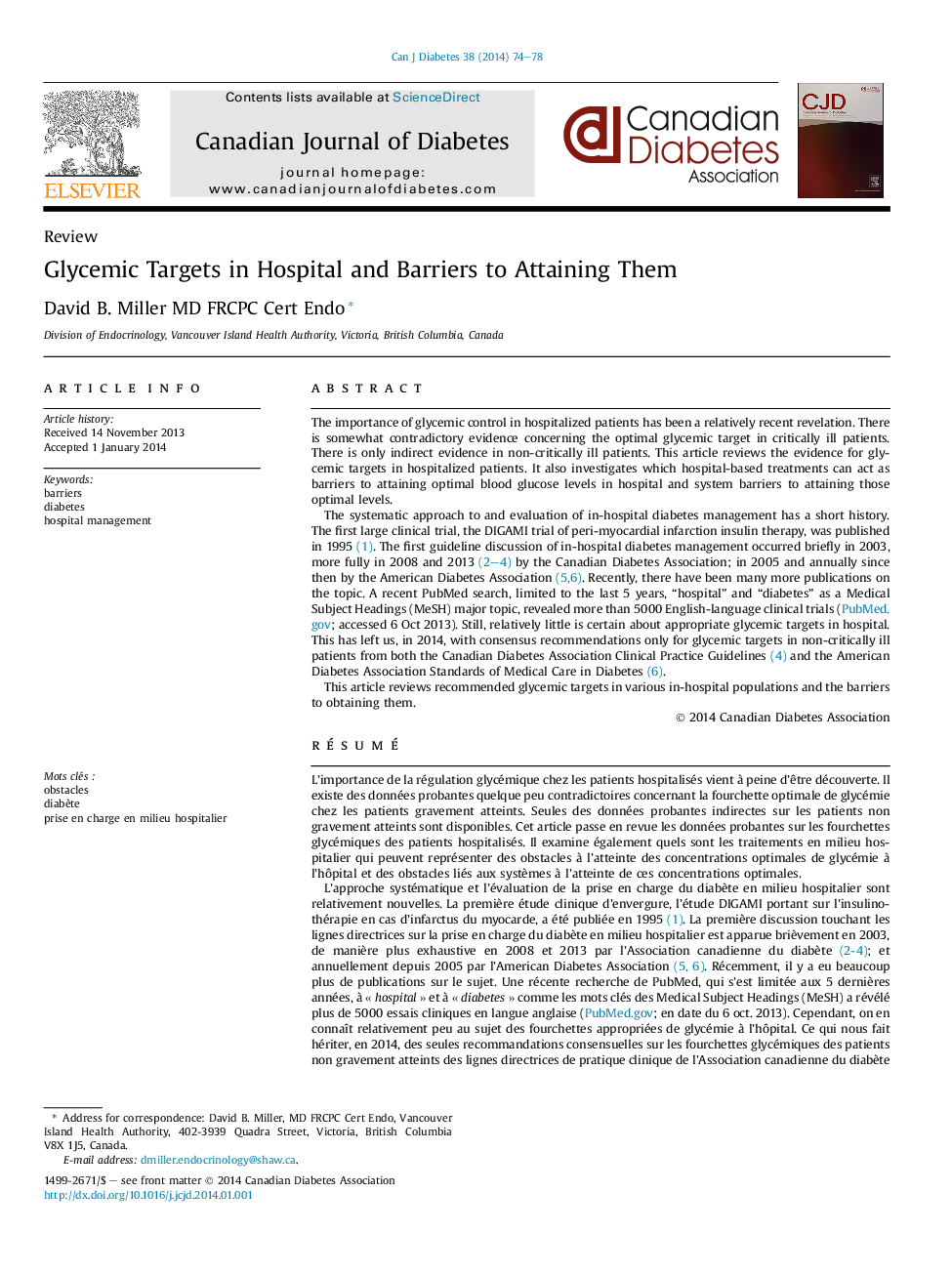| Article ID | Journal | Published Year | Pages | File Type |
|---|---|---|---|---|
| 3255187 | Canadian Journal of Diabetes | 2014 | 5 Pages |
The importance of glycemic control in hospitalized patients has been a relatively recent revelation. There is somewhat contradictory evidence concerning the optimal glycemic target in critically ill patients. There is only indirect evidence in non-critically ill patients. This article reviews the evidence for glycemic targets in hospitalized patients. It also investigates which hospital-based treatments can act as barriers to attaining optimal blood glucose levels in hospital and system barriers to attaining those optimal levels.The systematic approach to and evaluation of in-hospital diabetes management has a short history. The first large clinical trial, the DIGAMI trial of peri-myocardial infarction insulin therapy, was published in 1995 (1). The first guideline discussion of in-hospital diabetes management occurred briefly in 2003, more fully in 2008 and 2013 2, 3 and 4 by the Canadian Diabetes Association; in 2005 and annually since then by the American Diabetes Association 5 and 6. Recently, there have been many more publications on the topic. A recent PubMed search, limited to the last 5 years, “hospital” and “diabetes” as a Medical Subject Headings (MeSH) major topic, revealed more than 5000 English-language clinical trials (PubMed.gov; accessed 6 Oct 2013). Still, relatively little is certain about appropriate glycemic targets in hospital. This has left us, in 2014, with consensus recommendations only for glycemic targets in non-critically ill patients from both the Canadian Diabetes Association Clinical Practice Guidelines (4) and the American Diabetes Association Standards of Medical Care in Diabetes (6).This article reviews recommended glycemic targets in various in-hospital populations and the barriers to obtaining them.
RésuméL’importance de la régulation glycémique chez les patients hospitalisés vient à peine d’être découverte. Il existe des données probantes quelque peu contradictoires concernant la fourchette optimale de glycémie chez les patients gravement atteints. Seules des données probantes indirectes sur les patients non gravement atteints sont disponibles. Cet article passe en revue les données probantes sur les fourchettes glycémiques des patients hospitalisés. Il examine également quels sont les traitements en milieu hospitalier qui peuvent représenter des obstacles à l’atteinte des concentrations optimales de glycémie à l’hôpital et des obstacles liés aux systèmes à l’atteinte de ces concentrations optimales.L’approche systématique et l’évaluation de la prise en charge du diabète en milieu hospitalier sont relativement nouvelles. La première étude clinique d’envergure, l’étude DIGAMI portant sur l’insulinothérapie en cas d’infarctus du myocarde, a été publiée en 1995 (1). La première discussion touchant les lignes directrices sur la prise en charge du diabète en milieu hospitalier est apparue brièvement en 2003, de manière plus exhaustive en 2008 et 2013 par l’Association canadienne du diabète 2, 3 and 4; et annuellement depuis 2005 par l’American Diabetes Association 5 and 6. Récemment, il y a eu beaucoup plus de publications sur le sujet. Une récente recherche de PubMed, qui s’est limitée aux 5 dernières années, à « hospital » et à « diabetes » comme les mots clés des Medical Subject Headings (MeSH) a révélé plus de 5000 essais cliniques en langue anglaise (PubMed.gov; en date du 6 oct. 2013). Cependant, on en connaît relativement peu au sujet des fourchettes appropriées de glycémie à l’hôpital. Ce qui nous fait hériter, en 2014, des seules recommandations consensuelles sur les fourchettes glycémiques des patients non gravement atteints des lignes directrices de pratique clinique de l’Association canadienne du diabète (4) et des normes de soins médicaux de l’American Diabetes Association (6). Cet article passe en revue les fourchettes glycémiques recommandées chez les différentes populations en milieu hospitalier et les obstacles pour les atteindre.
